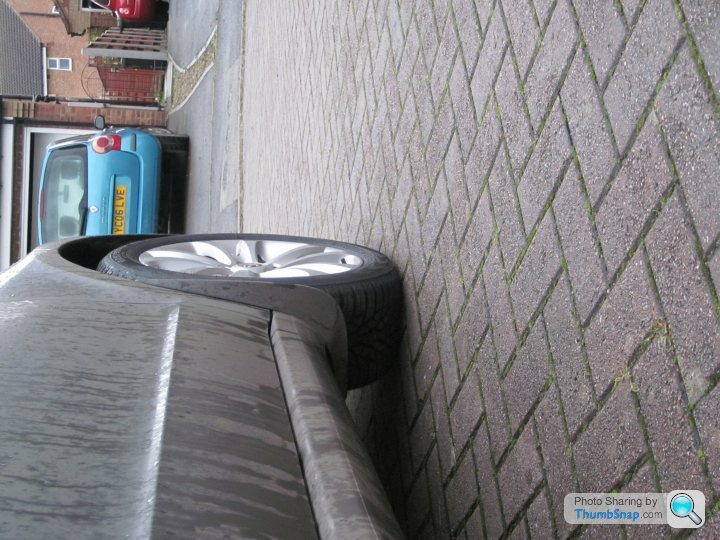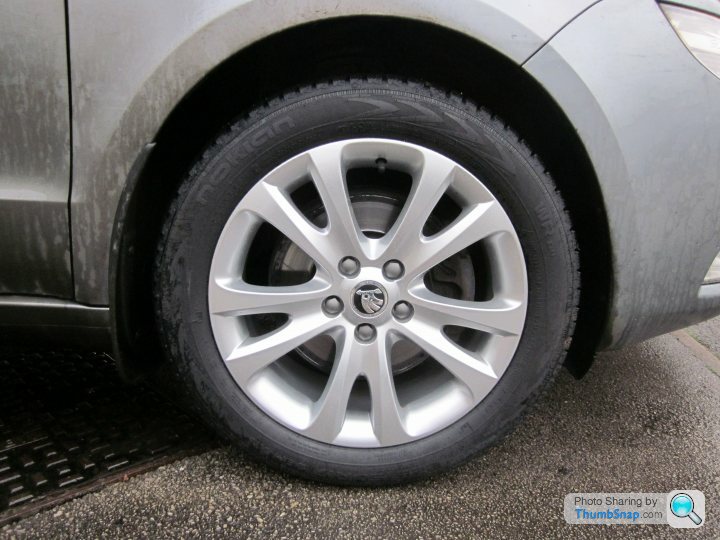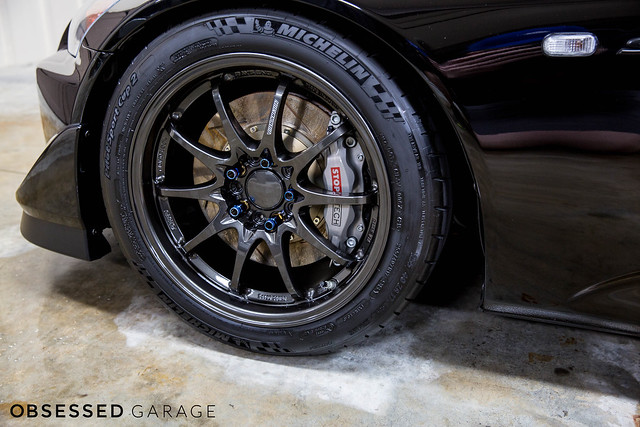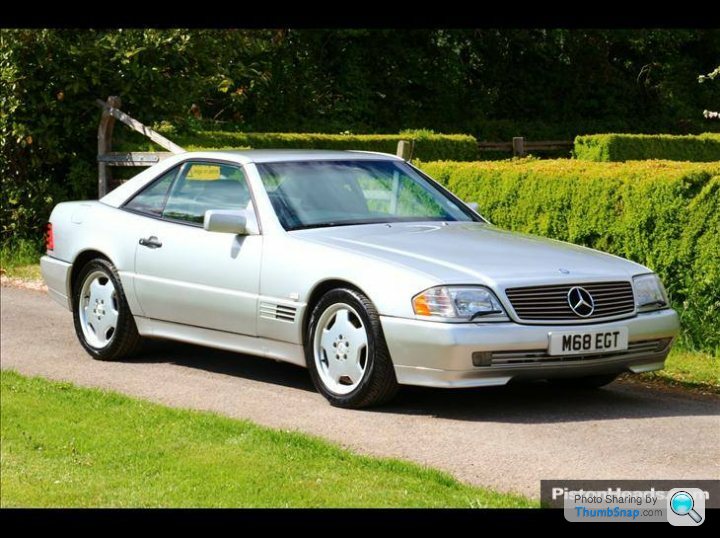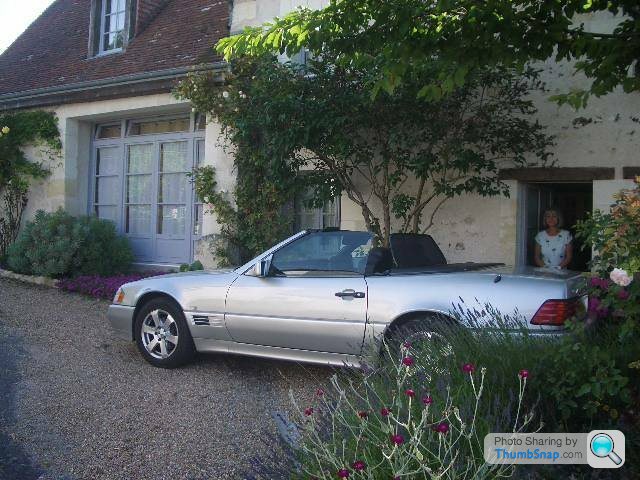Why do we have to have low profile tyres to look "sporty"?
Discussion
Toltec said:
PSRG said:
I’ve just bought a new, automatic supermini for my partner, with a 1 litre (albeit turbocharged) engine generating a heady 115PS. It’s fitted with 18” wheels (which, to be fair were optional...) and shod with 215/45/18 tyres 
Pretty sure they are 40 section not 45 looking at the photo. 

In comparison, my M235i (with nearly three times the power...) has 245/35/18s at the rear. And it’s winter wheel/tyre set up is, from memory, 225/45/17 all round

Edited by PSRG on Wednesday 21st March 22:56
I have 215/55/16 on my car instead of the 235/40/19 it came with.
The wheels are from the car maker in the same style as the larger and are the size as fitted on the standard model, the 'top ' spec, more powerful model got the larger wheels and lowered and stiffened suspension. The brakes are unaltered and therefore look a little lost in the larger wheel.
The benefits of running the smaller wheel are several. One, the wheel and tyre combo weigh 7.5 Kg less at each corner, making a total weight saving of 30 Kg.
Now this is unsprung weight meaning the handling is better as the suspension can control the lighter weight much better, keeping the tyres in contact with the road for longer on anything but smooth surfaces. Indeed I have seen it estimated that saving unsprung weight is worth several factors of supported weight. The car rides better, obviously, due to the higher profile tyres.
The car accelerates faster in any gear as well. A car accelerates by spinning up its rotating parts and when these are lighter it needs less power to spin them up or it will spin them up faster with the same power, especially when a lot of the extra weight is towards the outer circumference of the rotating body as with car wheels. A lighter smaller diameter crankshaft for instance would have little real effect.
Now these wheels actually have a smaller circumference than the issued ones, meaning that the speedometer is over reading a little more than is usual. I took the car past the radar speed indicator at the entrance to my village and at 42 on cruise it shows either 38 or 39 as real speed. Now this is ok by me and is very similar to what my last car was showing.
Are there any downsides? Well in theory the top speed could be affected but on my car top speed is reached not at peak revs but well before this, as its power finally can not push any more air out of the way. So everything being equal the car should attain the same top speed but at slightly higher revs. The equation power and wind resistance is the thing that is deciding the top speed.
However, not everything is still equal, these smaller tyres have about 15% less frontal area and car wheels are amongst the least aerodynamic things on a car. So the way to get more top speed is to either increase the power or lower the wind resistance and these wheels are lowering the wind resistance meaning the top speed should actually be raised.
Not only that the car is now sitting 30 mm lower than the standard car and the original ride height on the issued wheels.
When they lowered the car on the original wheels they were in fact just about making up for the increased height given by the larger wheels. Now this may also have reduced the overall wind resistance but of course there is no way to be 100% sure about this.
Another downside could be grip at the limit. The wider tyre should in theory provide more grip. It isn't putting any more rubber on the road than the smaller tyre, as the size of contact patch is decided by weight and tyre pressures alone and therefore they should be about the same.
The shape of the patch is different though, the narrower tyre will have a longer contact patch and the bigger tyre a wider but shorter patch.
The higher profile tyre will also have a larger slip angle, which can affect when it starts to lose grip. In reality though, tyres contact patches start to slide from the front of the contact patch, you can hear them squealing as part of the tyre starts to slide. The thinner tyre, with its longer contact patch, should therefore break away more progressively giving you more time to adjust, the wider contact patch will hang on a bit longer but because the patch is shorter will break away completely more quickly from the moment grip starts to be lost.
Not only that but as stated previously on any given corner, on anything but a smooth surface, the lighter wheel will be in contact with the road for longer as the suspension can more quickly get the wheel down from any bounce. On the usual UK road the lighter wheel may have more average traction through a given corner than the wider heavier wheel.
So really it is a no-brainer, apart from looks, which is subjective anyway, if you want best overall performance and drive-ability from your car, go with smaller wheels and higher profile tyres.
The wheels are from the car maker in the same style as the larger and are the size as fitted on the standard model, the 'top ' spec, more powerful model got the larger wheels and lowered and stiffened suspension. The brakes are unaltered and therefore look a little lost in the larger wheel.
The benefits of running the smaller wheel are several. One, the wheel and tyre combo weigh 7.5 Kg less at each corner, making a total weight saving of 30 Kg.
Now this is unsprung weight meaning the handling is better as the suspension can control the lighter weight much better, keeping the tyres in contact with the road for longer on anything but smooth surfaces. Indeed I have seen it estimated that saving unsprung weight is worth several factors of supported weight. The car rides better, obviously, due to the higher profile tyres.
The car accelerates faster in any gear as well. A car accelerates by spinning up its rotating parts and when these are lighter it needs less power to spin them up or it will spin them up faster with the same power, especially when a lot of the extra weight is towards the outer circumference of the rotating body as with car wheels. A lighter smaller diameter crankshaft for instance would have little real effect.
Now these wheels actually have a smaller circumference than the issued ones, meaning that the speedometer is over reading a little more than is usual. I took the car past the radar speed indicator at the entrance to my village and at 42 on cruise it shows either 38 or 39 as real speed. Now this is ok by me and is very similar to what my last car was showing.
Are there any downsides? Well in theory the top speed could be affected but on my car top speed is reached not at peak revs but well before this, as its power finally can not push any more air out of the way. So everything being equal the car should attain the same top speed but at slightly higher revs. The equation power and wind resistance is the thing that is deciding the top speed.
However, not everything is still equal, these smaller tyres have about 15% less frontal area and car wheels are amongst the least aerodynamic things on a car. So the way to get more top speed is to either increase the power or lower the wind resistance and these wheels are lowering the wind resistance meaning the top speed should actually be raised.
Not only that the car is now sitting 30 mm lower than the standard car and the original ride height on the issued wheels.
When they lowered the car on the original wheels they were in fact just about making up for the increased height given by the larger wheels. Now this may also have reduced the overall wind resistance but of course there is no way to be 100% sure about this.
Another downside could be grip at the limit. The wider tyre should in theory provide more grip. It isn't putting any more rubber on the road than the smaller tyre, as the size of contact patch is decided by weight and tyre pressures alone and therefore they should be about the same.
The shape of the patch is different though, the narrower tyre will have a longer contact patch and the bigger tyre a wider but shorter patch.
The higher profile tyre will also have a larger slip angle, which can affect when it starts to lose grip. In reality though, tyres contact patches start to slide from the front of the contact patch, you can hear them squealing as part of the tyre starts to slide. The thinner tyre, with its longer contact patch, should therefore break away more progressively giving you more time to adjust, the wider contact patch will hang on a bit longer but because the patch is shorter will break away completely more quickly from the moment grip starts to be lost.
Not only that but as stated previously on any given corner, on anything but a smooth surface, the lighter wheel will be in contact with the road for longer as the suspension can more quickly get the wheel down from any bounce. On the usual UK road the lighter wheel may have more average traction through a given corner than the wider heavier wheel.
So really it is a no-brainer, apart from looks, which is subjective anyway, if you want best overall performance and drive-ability from your car, go with smaller wheels and higher profile tyres.
Edited by Tigger2050 on Wednesday 21st March 22:51
Sheepshanks said:
It can get messy with insurance though, especially with the main stream companies. LV= had a little paddy when we I winter wheel and tyre set on wife's Tiguan, as they're 16" wheels, rather than the standard 17". They only seemed to accept it as I said it was VW's official winter set for Tiguan.
You rang your insurance company to tell them you were fitting winter tyres?It would never, ever occur to me to do that.
I don't think I've ever spoken to an insurance company unless I've been getting a quote.
Tim662 said:
Tyres with around 100mm of sidewall seem like the best compromise to me as well, I used to run 225/45/17 on an classic Impreza. The brakes didn't look as yours good though.Shakermaker said:
Flibble said:
How many cars have such large brakes that they couldn't fit a rim with a 45 profile tyre over? I'll give you a hint, it isn't many. Far more common is the rather daft look of a ~250 mm disc lost inside a 19" wheel.
What is the "45 profile" a percentage of though? 45% of 300mm or 45% of 225mm?What will fit over a brake isn't a variable - a 16" rim may fit or not, but changing the size/profile of the tyre won't make any difference! If the rim won't clear the brake it doesn't matter what tyre you put on the wheel.

delta0 said:
Low profile tyres increase grip so they will go faster. Most racing classes use 18” these days. As pointed out above F1 could use larger brakes as well which will further improve the performance.
You clearly have no idea what grip actually is.....Edited by Monty Python on Thursday 22 March 07:45
It's worth noting that only half of the ride quality and handling problems introduced by huge wheels comes from the size, the rest comes from the additional unsprung weight. Within reason, good (light) big wheels with low profile tyres don't ride that much worse than smaller wheels with higher tyres of the same overall weight.
Monty Python said:
You clearly have no idea what grip actually is.....
Considering the industry I work in I would hope so. I would recommend reading up the difference between low and high profile tyres. There are distinct benefits to low profile tyres and grip is one of them. Handling is also much improved due to the stiffer tyre. Tyre wear is however a disadvantage. Something that is often missed is that a lot of the very large wheels are actually forged so they often weigh less than their smaller counterparts.Edited by Monty Python on Thursday 22 March 07:45
PSRG said:
Crikey! Those are the tiniest brakes I've ever seen - they're like mountain bike diameter - so cute 
Tim662 said:
Nice - not a million miles off the pic in the first post.delta0 said:
Considering the industry I work in I would hope so. I would recommend reading up the difference between low and high profile tyres. There are distinct benefits to low profile tyres and grip is one of them. Handling is also much improved due to the stiffer tyre. Tyre wear is however a disadvantage. Something that is often missed is that a lot of the very large wheels are actually forged so they often weigh less than their smaller counterparts.
Sidewall stiffness has no impact on grip, which is why a high profile F1 slick can generate more grip than road tyre of the same width, irrespective of the profile.Grip is a combination of the coefficient of friction between the tyre and the road, and the mechanical interlocking between the tyre and the surface (which is governed by the tyre compound, the load applied 90 degrees to the surface and the contact area between the tyre and the surface).
If you think than a 225-width low-profile tyre grips as well as a 315-width tyre of the same profile, then I'd like to see your explanation.
Monty Python said:
Grip is a combination of the coefficient of friction between the tyre and the road, and the mechanical interlocking between the tyre and the surface (which is governed by the tyre compound, the load applied 90 degrees to the surface and the contact area between the tyre and the surface).
It's rather more complex than that. The structure of the tyre (including the stiffness of the sidewall) has a significant effect on whether the contact surface has pressure applied evenly across its width and that in turn has a big effect on the temperature gradient across the tyre. If the side-walls are rolling under the wheel slightly under hard cornering, you end up with a hot-spot on the outer shoulder of the tyre which both generates premature wear and, past a certain point, reduces grip. The profile of the tyre, coupled with the clearance between the brakes and rim, also has a significant effect on how consistent the temperature of the air within the tyre is and hence how much the tyre pressures vary under heavy driving.
All other things being equal, lower profile tyres do give more lateral grip on a smooth surface. The bumpier the surface, the more compliance you need to allow the tyre to soak the bumps without resorting to suspension movement (along with all of the problems of inertia mass that produces).
Edited by kambites on Thursday 22 March 08:36
MJ85 said:
Excellent video. It confirms what we have discussed. Extra grip and better handling. Increased side wall stiffness was a major contributor. Sheepshanks said:
It can get messy with insurance though, especially with the main stream companies. LV= had a little paddy when we I winter wheel and tyre set on wife's Tiguan, as they're 16" wheels, rather than the standard 17". They only seemed to accept it as I said it was VW's official winter set for Tiguan.
Strange LV on the ABI Winter Tyre Commitment is no and no. Additionally the only thing that some do accept is the last bit it has to be the approved sizes for tyre and wheel combos. Never had an issue changing mine down from 20" to 17".
For reference as well
Summer - 245/35/20, 275/30/20. The tyres are like a smear of rubber, the wheels are known to have issues as well, but I suspect the tyre profile does not help. They go back on next Saturday for Summer, why else do you think I have been busy moaning about potholes on my route to work routes! If only the M20 would be sorted now.
Winter - 225/55/17 square all round. A truly robust set of Winter tyres, tyres that cost anything between about 50 - 100 cheaper per corner as well and are much easier to get than the difficult to get front Summer tyres.
Monty Python said:
Sidewall stiffness has no impact on grip, which is why a high profile F1 slick can generate more grip than road tyre of the same width, irrespective of the profile.
I *really* don't want to get involved in this little spat, but here goes.... you can't really compare and F1 tyre with a road tyre in any meaningful way; there's downforce to consider, an F1 tyre will only last 60 or so miles. Look what happens when an F1 tyre loses heat or has to go slowly (ie. no downforce) in the damp/wet. They fall off the road. Sometimes they can't keep up with the safety car.Another hater of the trend for rubber band tyres here. My Leon Cupra has 19" wheels with barely any tyre showing. Unexpected potholes absolutely pound through the car and normally have me pulling over for a quick check. I'm very nervous parking anywhere near a kerb and the ride, although not as bad as it ought to be, is poor over many roads. I also think the car would look better with a wheels a couple of sizes smaller. It looks like the cartoon cars that Hugh J Teens drove in Max Power.
For some time I had an E39 that had 15" wheels (I think there may have been a factory 14" option too! ) and the ride was just fantastic. Had an E46 at the same time with 18" wheels and 35 profile tyres and the difference was so stark. The E39 felt like a magic carpet.
For some time I had an E39 that had 15" wheels (I think there may have been a factory 14" option too! ) and the ride was just fantastic. Had an E46 at the same time with 18" wheels and 35 profile tyres and the difference was so stark. The E39 felt like a magic carpet.
Dog Star said:
I'm getting increasingly naffed off with the ride quality and fragility of the silly wheels and tyres that are fitted to stuff these days, from the stupid, kerb vulnerable 30 profile tyres on my car to even run of the mill stuff like the OHs V70 (225/45). They're a pain in the arse (literally) and these days I'm cringing at the state of the roads.
I guess it's market forces, but wouldn;t it be lovely if this was the sort of wheel and tyre combo that became more fashionable....

Imagine the ride quality. Imagine your pristine rims. Just how cool would most cars look on a set of those? I think a lot of German kit riding around on 30 profiles would look better on these.
Is it just me?
That looks perfect. I guess it's market forces, but wouldn;t it be lovely if this was the sort of wheel and tyre combo that became more fashionable....

Imagine the ride quality. Imagine your pristine rims. Just how cool would most cars look on a set of those? I think a lot of German kit riding around on 30 profiles would look better on these.
Is it just me?
I'm thinking of getting a BMW M135i as my next car, but I can't stand the rubber-band tyres.
Gassing Station | General Gassing | Top of Page | What's New | My Stuff



